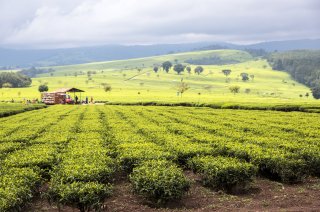
Food Loss and Waste country profile Kenya
Milk and maize are extremely critical hotspots in Kenya, closely followed by bovine meat and vegetables.
Urgency and call for action on Food Loss and Waste (FLW) reduction
Globally, each year possibly as much as 30% of the food produced is being lost or wasted somewhere between farm and fork. Food Loss and Waste (FLW) accounts for around 8 to 10% of our global Greenhouse Gas Emissions (GHGEs). Approximately a 25% of all freshwater used by agriculture is associated to the lost and wasted food. 4.4 million km² of land is used to grow food which is lost or wasted. The Sustainable Development Goal (SDG) Target 12.3 calls to ‘halve per capita global Food Waste at the retail and consumer levels and reduce Food Losses along production and supply chains, including post-harvest losses’. With only 6 years to go, the world is far from being on track to achieve this target.
FLW, GHGEs, nutrition, land use and water footprint country profile Kenya
Based on the country data modelling, estimates on FLW-associated GHGEs were retrieved for Kenya and plotted with the FLW total tonnage to visualize the two components (Figure 1). For FLW the five main hotspots products are: vegetables (others), bananas, fruits (others), milk and potatoes. However, ranking food categories according to the production of FLW-associated GHGEs the five hotspot products for Kenya are: milk, bovine meat, maize, mutton & goat meat, and vegetables (others).
From the milk chains, 1.3 million tons of FLW represents 5.4 million tons CO2-eq. of GHGEs. For the bovine meat chains, 3.4 million tons CO2-eq. of GHGEs are generated from 0.1 million tons of FLW.
Figure 2 presents the top 15 items with the largest land-use footprints of FLW. Bovine meat, milk and maize ranks the top 3. With respect to the water footprints of the FLW, milk and maize are the top 2, followed by beans and bananas (Figure 3).
From another perspective, taking the percentages of FLW in relation to production percentages, the vegetable and fruit products arise as the main hotspots showing average FLW of 65% along the chains (Figure 4).
(e.g. arrangements in chains) and software (knowledge, information) elements.
Figure 6 shows the protein losses associated with FLW where vegetables, maize, milk, bovine meat, and bananas ranks the top 5. Finally, the food supply and FLW data were used to assess nutrient supply per capita in the Kenyan population in relation to recommended nutrient intake (Figure 7). These are average numbers, and it is not likely that nutrients are evenly distributed across Kenya. Hence, there will be parts of the populations that suffer insufficiencies of calcium, vitamin A, vitamin B12 and zinc. From nutrition security perspective, efforts for mitigating FLW in milk/dairy, fresh vegetables, and bean chains would contribute the most to population nutrient gains (Table 1).
Overall conclusions and suggestions for the next steps
Figure 8 displays a comprehensive ranking of hotspot food products based on five criteria. While there are eight hotspot food products identified, a closer examination reveals notable variations in the ranking of the eight hotspot products across different categories. Milk and maize emerge as extremely critical food products, with milk taking the lead in this category and ranked as the most critical product. Bovine meat and vegetables follow closely, positioned as a hotspot for four categories and therefor classified as very critical products. In the next tier of hotspot products, banana stand out among the top five hotspots for three categories and belongs into the category of critical products. Whereas bean
is among the top 5 hotspot products in two categories and is classifies as a moderately critical product. Fruits and mutton goat meat are identified as a hotspot for one category each and are categorized as slightly critical. It is suggested to develop FLW reduction actions, with synergy on GHGEs mitigation, nutrition, land-use and water footprints. The above analysis underlines that, if one considers sustainability in the context of these five selected indicators the greatest impact can be achieved by concentrating efforts on milk, maize, bovine meat and vegetables compared to focusing on other food products.
Since the results are not on product level, it is not immediately clear, where to start your intervention. Our suggestion to develop FLW reduction actions, with synergy on GHGEs mitigation, nutrition, land-use and water footprints, is to implement monitoring or/and gather primary data for hotspot-supply chains of the country. The results in this document guide stakeholders by focusing on the top four food (sub)categories in combination with the indicative results on FLW per supply chain link. To research interventions, it is necessary to go to product level, which can be based on production or trade data in the country. The next step is to identify business cases for FLW reduction. For this purpose, WUR’s EFFICIENT protocol and FLW cause and intervention tool can be used.